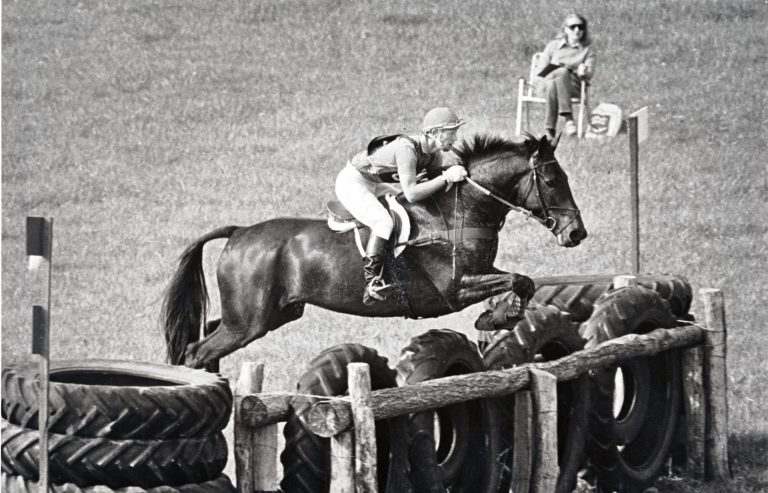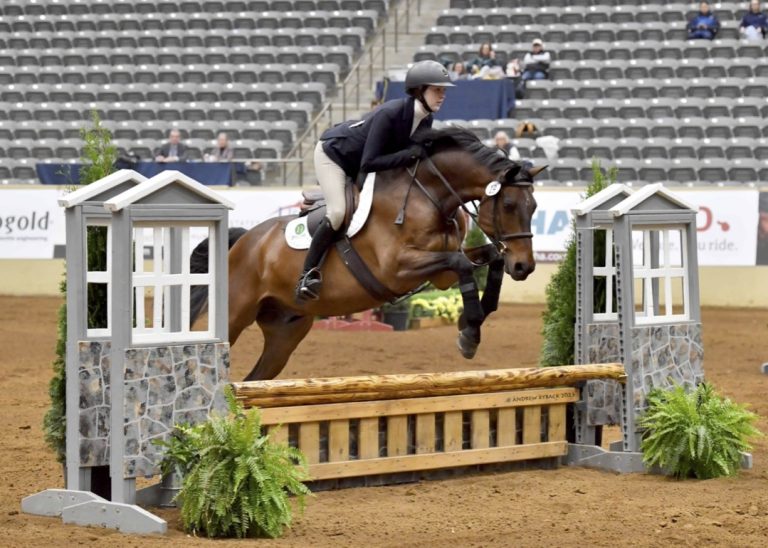 Courtesy, Las Vegas News Bureau
Courtesy, Las Vegas News BureauZinging lasers, popping fireworks, split-second timing that leaves the audience breathless: There’s magic beyond the show jumping and dressage when the World Cup finals are staged in Las Vegas.
The man behind that magic is Shawn Davis, the 74-year-old genius who crafted the Wrangler National Finals Rodeo into one of the country’s most popular sporting events. Every December, the NFR draws a sold-out house of approximately 17,000 to the Thomas & Mack Center for 10 nights.
 Shawn Davis is the master of the meeting, whether he’s at the Wrangler National Finals Rodeo or the World Cup finals. During meetings, he insists attendees turn off cellphones or risk a fine of whiskey or Dr Pepper. | © Nancy Jaffer
Shawn Davis is the master of the meeting, whether he’s at the Wrangler National Finals Rodeo or the World Cup finals. During meetings, he insists attendees turn off cellphones or risk a fine of whiskey or Dr Pepper. | © Nancy JafferAlthough the numbers aren’t yet at that level for the Longines FEI Show Jumping and Reem Acra Dressage World Cup Finals, April 15–19 at Thomas & Mack, Shawn’s presence as the production manager generates not only a good turnout but also guarantees that those attending will have a good time. They call him the man who put “the rock into rodeo.” Along those lines, you could say he put “the wow into World Cup.”
“You come to Vegas and you expect something different than what a traditional World Cup Final is,” says Tim Keener, vice president of Las Vegas Events, which produces the finals, adding that he thinks the approach has been transformative.
Experience ‘By Accident’
 To ensure the split-second timing of the competition and acts, Production Manager Shawn Davis is in constant touch with his team during the Wrangler National Finals Rodeo last December, as he will be during the upcoming World Cup finals. | © Nancy Jaffer
To ensure the split-second timing of the competition and acts, Production Manager Shawn Davis is in constant touch with his team during the Wrangler National Finals Rodeo last December, as he will be during the upcoming World Cup finals. | © Nancy JafferBuilding blocks of the wizardry involve hard work and leadership from Shawn, a three-time saddle bronc world champ and Pro Rodeo Hall of Fame member, who knows how to pluck what he needs from Las Vegas’ dazzling array of entertainment.
He likes to say he got his production expertise “by accident.” In the era when he was rodeoing, he was one of the few contestants in college. He was at ease speaking with reporters and had no problem handling TV or radio, so he often was selected to do media interviews.
“In doing so, I learned a lot from some very good people,” he says, explaining that he picked up what organizers were trying to achieve and how they were filling the stands. His own natural ability to organize served him well when he got involved with the student rodeo at the then-called Western Montana College.
Rodeo didn’t have much clout on campus until he started working with the athletic department as a trainer while still a student. That link enabled him to get the athletic department to support the rodeo. A key to improving its standing was recruiting sororities to help. He had young women do everything from driving trucks to rounding up awards and selling program ads.
“Because of the popularity of the sorority girls, all the athletes wanted to be involved,” he reminisces with a chuckle.
Valuable lessons in how to make an event succeed formed a basis for his current career. “I could always find a way to get stuff done,” Shawn recalls.
Nonstop Action
 Guenter Seidel and Elizabeth Ball produced the winning Phantom of the Opera routine in a special pas de deux competition at the 2009 World Cup finals. | © Nancy Jaffer
Guenter Seidel and Elizabeth Ball produced the winning Phantom of the Opera routine in a special pas de deux competition at the 2009 World Cup finals. | © Nancy JafferWhen the show-jumping World Cup Final debuted at Thomas & Mack 15 years ago, Shawn was drafted “to give it some of the pace and energy of rodeo.” He used his NFR experience to mold the competition. “The World Cup is a whole different event because of that. It’s got a faster pace. It’s got more entertainment,” says Pat Christenson, president of Las Vegas Events. The goal was to rev up spectators—used to the yawn gaps in regular horse shows—until the final victory pass.
For the World Cup, Shawn planned to fill “all the pauses. It worked. At the break, instead of letting the crowd sit and not do anything, we filled it with excitement and tightened that stuff into a time frame so people could enjoy themselves. We put in a lot of things they’d never seen at horse shows and added openings and closings.”
When dressage became part of the Cup program in 2005, there was a bit of a transition. As Shawn started talking to the announcer during a dressage test, he remembers, “I had several people turn around and shush me.”
It was a signal to Shawn that things needed to become increasingly interactive with that discipline. “The more we added to the entertainment and crowd participation, the better it was accepted,” he says. In 2009, the addition of the pas de deux let the audience vote for its favorite pairs with applause. “People just loved it because they were part of it,” says Shawn. “By the end of the week, they were the wildest group we ever had.”
Despite the similarities between putting on the NFR and the World Cup, there are differences that prompt Shawn to say, “The World Cup, on the setup, is more than we’ve got for the rodeo because we’ve got more stringent requirements.”
As he points out, the show jumpers and dressage riders have different needs for their horses than the more casual rodeo contingent. The Cup also involves the flights bringing horses from Europe and elsewhere as well as having to quarantine.
 Showgirls from Las Vegas give World Cup spectators a glimpse of what casinos have to offer. | © Nancy Jaffer
Showgirls from Las Vegas give World Cup spectators a glimpse of what casinos have to offer. | © Nancy JafferDuring the buildup to the finals, “there’s stuff going on here for a month,” says Shawn, also noting that each session of the finals is longer than the two-hour format of the rodeo, and it’s more intense because for three days there are afternoon and evening performances while the NFR runs only one at night.
In the five years since the Cup finals were last in the city, “we’ve got lots of changes, from lighting effects to sound,” he notes. An important element to success is “the personnel and the talent [that competitions] can’t afford anywhere else,” Shawn says. “The casinos want to give a little feel for what we’ve got to show. We can get things out of their resources to show here we couldn’t afford other places.” Stay tuned for his latest feature at this year’s finals—an event using cattle that involves surprises. Part of the formula is “having things to entertain the fans that they wouldn’t get an opportunity to see anywhere else,” Shawn says. “We’ll use a certain amount of a Las Vegas theme.”
Attention to Details
 The Budweiser Clydesdales were well received at the 2003 World Cup finals. | © Nancy Jaffer
The Budweiser Clydesdales were well received at the 2003 World Cup finals. | © Nancy JafferAnother reason the World Cup finals in Las Vegas will dazzle? Shawn’s character and work ethic. “He’s very straightforward. He’s a cowboy,” says Pat. “He’s demanding—that’s why the show is run so tight and why the show is run so well.”
Whether it’s horse feed, footing, parking or fencing, “There’s not one item he won’t go over,” adds Tim.
Multiple morning meetings are a staple of both the NFR and World Cup. During these sessions, Shawn rules the roost and lets nothing get by him. After his gavel goes down, no one speaks until called on by the man wearing the cowboy hat.
As one meeting finishes at the Cox Pavilion, next to Thomas & Mack, the next group is called in. Participants make sure their cellphones are turned off. There’s a handmade sign on the wall that lists the names of transgressors whose phones have rung and whether they have paid their fine—a bottle of whiskey for the group or a six-pack of Dr Pepper Diet for Shawn, who doesn’t drink alcohol.
Allen Rheinheimer, the assistant technical director for the World Cup who also is involved with the NFR, calls Shawn, “fantastic to work with. He allows people to do their jobs but gives them support when it’s needed.”
One of the keys to Shawn’s successful efforts, in Allen’s view, is that “he understands live performance and what people in the seats are geared to. We do everything down to the second. If it’s supposed to be 45 seconds, it’s 45; it’s not 48, it’s not 47, it’s 45.” Shawn doesn’t want the spectators’ minds to wander. And, as Allen puts it, “He’s got a mind for details.”
 The World Cup arrives in style at the 2009 finals at the Thomas & Mack Center. | © Nancy Jaffer
The World Cup arrives in style at the 2009 finals at the Thomas & Mack Center. | © Nancy Jaffer“The only thing between being average and outstanding is details,” believes Shawn. “If you don’t do details, it becomes flat. Look at the help in the arena. I want my judges to look alive, like something important is going on. That’s an atmosphere that carries into your audience. My job is to make it the best I can and better than before.”
This article originally appeared in the April 2015 issue of Practical Horseman.










